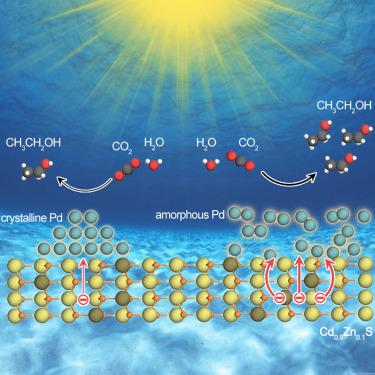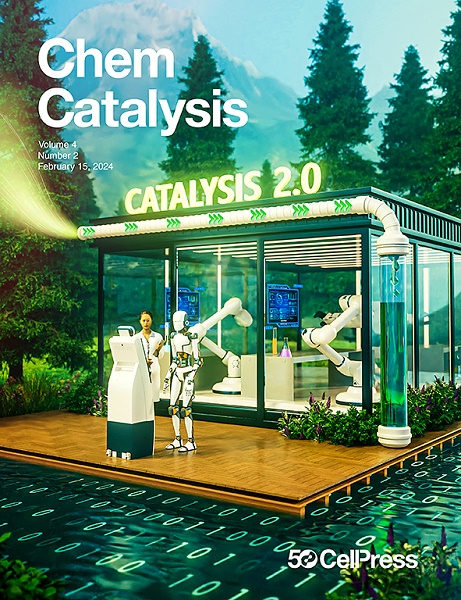CO2-to-C2H5OH photoconversion by an amorphization-activated catalyst
IF 11.5
Q1 CHEMISTRY, PHYSICAL
引用次数: 0
Abstract
CO2 photoconversion into value-added C2 products with high selectivity and efficiency is formidably challenging due to highly energetic and kinetic restriction of C–C coupling. Designing catalysts to overcome those barriers is therefore crucial. Here, for the first time, we demonstrate an amorphization strategy to boost photocatalytic CO2 ethanolization. By integrating amorphous Pd onto Cd0.9Zn0.1S nanorods (a-Pd/CZS), an activity of 412.1 μmol g−1 h−1 and a selectivity of 96.5% for CO2-to-C2H5OH photoconversion were achieved without a sacrificial agent with an apparent quantum efficiency (AQE) of 0.87% at 420 nm. The superior performance results from rapid migration of photogenerated electrons to amorphous Pd via interfacial Ohmic junction. In situ characterization and theoretical calculation further reveal that amorphous Pd can optimize CO2 adsorption/activation and reduce the C–C coupling energy barrier via intensified interaction and stabilization with a ∗OCCO intermediate, thereby maximizing conversion efficiency and selectivity. This work highlights an efficient photocatalyst for a CO2-to-C2 product and inspires high-performance photocatalyst design.

非晶化活化催化剂的co2到c2h5oh光转化
由于碳-碳耦合的高能量和动力学限制,CO2光转化为高选择性和高效率的增值C2产品是非常具有挑战性的。因此,设计催化剂来克服这些障碍至关重要。在这里,我们首次展示了一种促进光催化CO2乙醇化的非晶化策略。将非晶态Pd集成到Cd0.9Zn0.1S纳米棒(a-Pd/CZS)上,在420 nm处,无牺牲剂的co2 - c2h5oh光转化活性为412.1 μmol g−1 h−1,选择性为96.5%,表观量子效率(AQE)为0.87%。优越的性能是由于光电子通过界面欧姆结快速迁移到非晶Pd。原位表征和理论计算进一步表明,非晶钯可以通过增强与OCCO中间体的相互作用和稳定,优化CO2吸附/活化,降低C-C耦合能垒,从而最大化转化效率和选择性。这项工作突出了CO2-to-C2产品的高效光催化剂,并激发了高性能光催化剂的设计。
本文章由计算机程序翻译,如有差异,请以英文原文为准。
求助全文
约1分钟内获得全文
求助全文
来源期刊
CiteScore
10.50
自引率
6.40%
发文量
0
期刊介绍:
Chem Catalysis is a monthly journal that publishes innovative research on fundamental and applied catalysis, providing a platform for researchers across chemistry, chemical engineering, and related fields. It serves as a premier resource for scientists and engineers in academia and industry, covering heterogeneous, homogeneous, and biocatalysis. Emphasizing transformative methods and technologies, the journal aims to advance understanding, introduce novel catalysts, and connect fundamental insights to real-world applications for societal benefit.

 求助内容:
求助内容: 应助结果提醒方式:
应助结果提醒方式:


